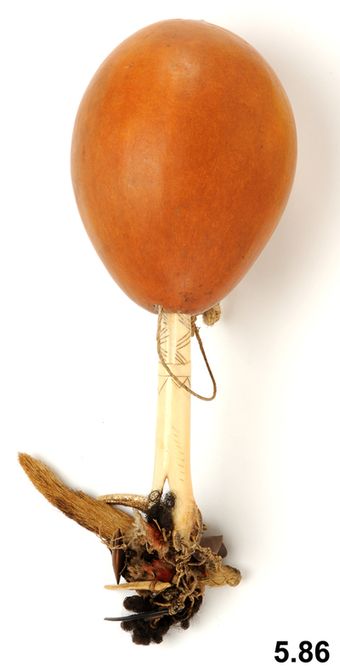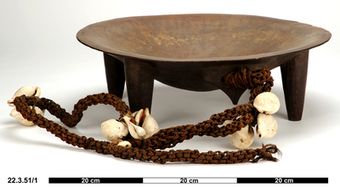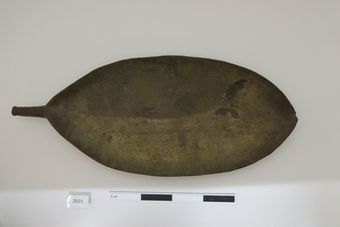Connect with Horniman Museum and Gardens
Contact this content partner to get more information about this item.
lime spatula (narcotics & intoxicants: chewing)
- Description:
- Lime Spatula, Kena, Trobriand Islands, Milne Bay Province, Papua New Guinea. The addictive stimulant drug Areca catechu (buai, the betel nut) is chewed by many men throughout New Guinea and Melanesia as far east as the Solomon Islands. This drug was introduced into Melanesia through Indonesia in prehistoric times, and a vast array of beautiful tools and containers have been developed for processing, storing and using the betel nuts themselves, and the powdered limestone consumed with them. This powdered limestone (kambang, usually ground-up coral) undergoes a chemical reaction with the active ingredient Arecoline in the nuts, and makes its effect much stronger. In Asia, the lime is usually wrapped up in a little betel-leaf parcel with the sliced nuts. In Melanesia, however, the nuts are chewed up directly, and a small dab of powdered lime is dipped from inside a storage container with a saliva-wetted tool known as a lime spatula. Lime spatulas from the Trobriand Islands are among the most varied and artistically impressive versions of these tools to be found, and this is an exceptionally good example. As a result, it is likely to come from the eastern part of the archipelago, perhaps Kitava Island which was famous for its ebony-work. Black hardwood. Early 20th Century. Formerly in the private collection of Sir Everard im Thurn. Exceptionally fine lime spatula in Massim ebony incorporating janiform busts and opposing birds, crocodiles and various scroll elements.
- Format:
- image
- Collections:
- Horniman Museum and Gardens
- Content partner:
- Horniman Museum and Gardens
- Availability:
- Not specified
-
Copyright status: All rights reservedFind out more about what you are able to do with this itemThis item is all rights reserved, with means you'll have to get permission from Horniman Museum and Gardens before using it. For more information, please see our use and reuse page.More informationHorniman Museum and Gardens has this to say about the rights status of this item:
http://rightsstatements.org/vocab/InC/1.0/
What can I do with this item?Non-infringing useNZ copyright law does not prevent every use of a copyright work, and this item may be hosted by an international institute or organisation. You should consider what you can and cannot do with a copyright work.No sharingYou may not copy and/or share this item with others without further permission. This includes posting it on your blog, using it in a presentation, or any other public use.No modifyingYou are not allowed to adapt or remix this item into any other works.No commercial useYou may not use this item commercially.
Welcome and warm Pasifik greetings
The information on this site has been gathered from our content partners.
The names, terms, and labels that we present on the site may contain images or voices of deceased persons and may also reflect the bias, norms, and perspective of the period of time in which they were created. We accept that these may not be appropriate today.
If you have any concerns or questions about an item, please contact us.



